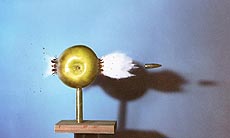Shooting a nuclear apple
 |
| Sometimes exotic physics has some very familiar analogs. When scientists collide lead nuclei together, the exiting debris acts much like a bullet traveling through an apple. |
One of the interesting things about science is how easy it is sometimes to draw analogies between the familiar and the exotic as a way to make the unfamiliar seem more intuitive. Today's article is a perfect example of that.
Let's start by talking about what happens when you shoot two billiard balls together on an otherwise bare table. If you snap a photo after the collision, you see two balls moving away from the collision point and nothing else.
Now imagine a similar scenario in which you shoot two bullets at one another and arrange for them to collide inside an apple. If you took a photo of the bullets after the collision, you'd see the bullets leaving the apple, but you'd also see lots of apple debris following the bullet. The effect of the bullet plowing through the fruit caused the apple bits to "explode" out of the apple. If you had a super fancy camera, you'd even see that the bullet's having to push its way through the apple caused it to slow down. Energy was transferred from the bullet to the apple.
LHC collisions have some very similar properties. For instance, imagine shooting two protons at one another, which is the normal way we operate the LHC. One of the constituents from each proton would collide and exit the collision, much like the billiard balls mentioned above. Frequent readers of this column will remember that these outgoing particles will turn into jets, which are a bunch of particles all moving in approximately the same direction as the parent particle. But this is a small sophistication, and what we observe is two blasts of particles moving out of the collision.
About one month a year, the LHC collides nuclei of lead, which means that when the collision between two proton or neutron constituents occurs, the collision is engulfed in a sphere of the 416 protons and neutrons that make up these two lead nuclei. When the scattered particles leave the collision point, they have to push their way through the surroundings, just like a bullet leaving the apple. The net effect is that the scattered particles lose some of their energy, and a lot of nuclear debris also accompanies them.
So CMS scientists went looking, not so much for the particles leaving the collision, but for the "nuclear apple debris." The analysis hinged on events in which two jets were made in collisions between two lead nuclei.
In the absence of having to plow through nuclear matter, the two jets should have equal energy transverse to the direction of the beam. If, however, the collision occurred near the edge of the nuclear material, one jet will emerge essentially unscathed, while the other would have to plow through a lot of the "nuclear apple." You'd then expect this jet to have lost energy, but also to see a lot of extra particles as the jet passed through the nuclear material. And this is exactly what was seen. This analysis can teach us a lot about the behavior of hot nuclear matter. And it underscores how the exotic often mimics the familiar.
—Don Lincoln
 |
| These MIT U.S. CMS scientists made important contributions to this analysis. From left: Chris McGinn, Austin Baty, Doga Gulhan, Yen-Jie Lee. |
|